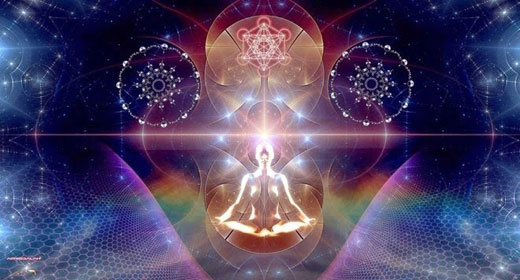By Pema Chödrön: It’s not life that causes suffering, says Buddhist teacher Pema Chödrön, it’s our story about life…
our interpretation—that causes so much distress. When we practice interrupting the story we’re telling ourselves, we can find a new freedom and flexibility in the face of uncertainty and change.
My granddaughter’s university professor asked her students to leave their cell phones behind when they came to class. My granddaughter was amazed at how much more present and alert she was as a result. She observed that her whole generation was getting in-depth, intensive training in being distracted. To me, this underscores how important it is for her generation, and the generations that follow, and the generations that came before, to counter this trend by getting intensive training in staying present.
Notice Your Particular Story
When you practice staying present, one thing you’ll quickly discover is how persistent the story line is. Traditionally, in the Buddhist texts, our tendencies with their habitual story lines are described as seeds in the unconscious. When the right causes and conditions come together, these preexisting propensities pop up like flowers in the springtime. It’s helpful to contemplate that it’s these propensities and not what triggers them that are the real cause of our suffering.
I had a dream about my ex-husband: I was just settling down for a quiet evening at home when he arrived with six unknown guests and then disappeared, leaving me to take care of them. I was furious. When I woke up, I thought ruefully, “So much for being finished with anger: I guess the propensity is still there.” Then I started thinking about an incident that had occurred the previous day, and I began to get furious all over again. This completely stopped me in my tracks, and I realized that waking or sleeping, it’s just the same. It isn’t the content of our movie that needs our attention, it’s the projector. It isn’t the current story line that’s the root of our pain; it’s our propensity to be bothered in the first place.
The propensity to feel sorry for ourselves, the propensity to be jealous, the propensity to get angry—our habitual, all-too-familiar emotional responses are like seeds that we just keep watering and nurturing. But every time we pause and stay present with the underlying energy, we stop reinforcing these propensities and begin to open ourselves to refreshingly new possibilities.
Learn to Interrupt Your Thoughts
As you respond differently to an old habit, you may start to notice changes. In the past when you got angry, it might have taken you three days to cool down, but if you keep interrupting the angry thoughts, you may get to the point at which it takes only a day to drop the anger. Eventually, only hours or even one and a half minutes. You’re starting to be liberated from suffering.
It’s important to realize that interrupting thoughts isn’t the same as repressing them. Repression is denial of what’s happening, which only sends the thoughts underground where they can fester. At the same time, we don’t want to keep chasing after the thoughts and getting hooked by them. Interrupting thoughts is somewhere between clinging to them and pushing them away. It’s a way of allowing the thoughts to come and go, to arise and pass, to not be such a big deal.
The practice is to train in not following the thoughts, not in getting rid of thought altogether. That would be impossible. You may have thought-free moments and, as your meditation practice deepens, longer expanses of time that are thought free, but thoughts always come back. That’s the nature of mind. You don’t have to make thoughts the villain, however. You can just train in interrupting their momentum. The basic instruction is to let the thoughts go—or to label them “thinking”—and stay with the immediacy of your experience.
Everything in you will want to do the habitual thing, will want to pursue the story line. The story line is associated with certainty and comfort. It bolsters your very limited, static sense of self and holds out the promise of safety and happiness. But the promise is a false one; any happiness it brings is only temporary. The more you practice not escaping into the fantasy world of your thoughts and instead contacting the felt sense of groundlessness, the more accustomed you’ll become to experiencing emotions as simply sensation—free of concept, free of story line, free of fixed ideas of bad and good.
Invite Your Nemesis to Tea
Still, the tendency to scramble for security will try to reassert itself and gain some ground. We can’t underestimate the very real (and very fleeting) comfort it provides. The meditation teacher Tara Brach, in her book Radical Acceptance, describes a practice she uses at such times. It’s based on the Buddha’s encounters with his nemesis, Mara, a demon who kept appearing to tempt the Buddha to give up his spiritual resolve and go back to his old unaware ways.
Psychologically, Mara represents the false promise of happiness and security offered by our habitual responses. So whenever Mara appeared, often with beautiful women or other temptations in tow, the Buddha would say, “I see you, Mara. I know you’re a trickster. I know what you’re trying to do.” And then he’d invite his nemesis to sit down for tea. When we’re tempted to go back to our habitual ways of avoiding groundlessness, we can look temptation in the eye and say, “I see you, Mara,” then sit down with the fundamental ambiguity of being human without any judgment of right or wrong.
Get Curious About Yourself
In a book I read recently, the author talked about humans as transitional beings—beings who are neither fully caught nor fully free but are in the process of awakening. I find it helpful to think of myself this way. I’m in the process of becoming, in the process of evolving. I’m neither doomed nor completely free, but I’m creating my future with every word, every action, every thought. I find myself in a very dynamic situation with unimaginable potential. I have all the support I need to simply relax and be with the transitional, in-process quality of my life. I have all I need to engage in the process of awakening.
Rather than living a life of resistance and trying to disprove our basic situation of impermanence and change, we could contact the fundamental ambiguity and welcome it. We don’t like to think of ourselves as fixed and unchanging, but emotionally we’re very invested in it. We simply don’t want the frightening, uneasy discomfort of feeling groundless. But we don’t have to close down when we feel groundlessness in any form. Instead, we can turn toward it and say, “This is what freedom from fixed mind feels like. This is what freedom from closed-heartedness feels like. This is what unbiased, unfettered goodness feels like. Maybe I’ll get curious and see if I can go beyond my resistance and experience the goodness.”
Buddhism holds that the true nature of the mind is as vast as the sky and that thoughts and emotions are like clouds that, from our vantage point, obscure it. We’re taught that if we want to experience the boundlessness of the sky, we’ll need to get curious about those clouds. When we look deeply into the clouds, they fall apart, and there’s the expanse of sky. It never went anywhere. It has always been here, momentarily hidden from us by the fleeting, shifting clouds.
The journey of awakening takes discipline and courage. Letting go of our cloud-like thoughts and emotions is by no means habitual at first. The thoughts and emotions may make it difficult for us to contact the openness of our minds, but they’re like old friends who have accompanied us for as long as we can remember, and we’re very resistant to saying good-bye. But each time you begin to meditate, you can decide that you’re going to see if you can let the thoughts go and be right here with the immediacy of your experience. Perhaps you can be right here for only five seconds today, but any progress in the direction of nondistraction is positive.
Chögyam Trungpa had an image for our tendency to obscure the openness of our being; he called it “putting makeup on space.” We can aspire to experience the space without the makeup. Staying open and receptive for even a short time starts to interrupt our deep-seated resistance to feeling what we’re feeling, to staying present where we are.
Find a Different Perspective
Believing in the story line—identifying with the interpretations we put on our experience—is deeply ingrained in us. We assert our opinions as if they were indisputable: “Jane really is intrinsically horrible. I know this for a fact.” “Ralph is intrinsically charming. There is absolutely no doubt about it.”
The way to weaken the habit of clinging to fixed ideas and contact the fluidity of thoughts and emotions is to shift your focus to a wider perspective. Instead of getting caught in the drama, see if you can feel the dynamic energy of the thoughts and emotions. See if you can experience the space around the thoughts: experience how they arise in space, dwell for a while, and then return into space.
If you don’t suppress the thoughts and emotions and don’t run with them, then you find yourself in an interesting place. The place of not rejecting or justifying is right in the middle of nowhere. It is here that you can finally embrace what you’re feeling. It is here that you can look out and see the sky.
As you’re meditating, memories of something distressing that happened in the past may bubble up. It can be quite freeing to see all of that. But if you revisit the memory of something distressing over and over, rehashing what happened and obsessing on the story line, it becomes part of your static identity. You’re just strengthening your propensity to experience yourself as the one who was wronged, as the victim. You’re strengthening a preexisting propensity to blame others—your parents and anyone else—as the ones who wronged you.
Continuing to recycle the old story line is a way of avoiding fundamental ambiguity. Emotions stay on and on when we fuel them with words. It’s like pouring kerosene on an ember to make it blaze. Without the words, without the repetitive thoughts, the emotions don’t last longer than one and a half minutes.
Our identity, which seems so reliable, so substantial, is in fact very fluid, very dynamic. There are unlimited possibilities to what we might think, what we might feel, and how we might experience reality. We have what it takes to free ourselves from the suffering of a fixed identity and connect with the fundamental slipperiness and mystery of our being, which has no fixed identity.
Use What’s Here Right Now
Your sense of yourself—who you think you are at the relative level—is a very restricted version of who you truly are. But the good news is that you can use your direct experience—who you seem to be at this very moment—as the doorway to your true nature. By fully touching this relative moment of time—the sound you’re hearing, the smell you’re smelling, the pain or comfort you’re feeling right now—by being fully present to your experience, you contact the unlimited openness of your being.
All of our habitual patterns are efforts to maintain a predictable identity: “I am an angry person”; “I am a friendly person”; “I am a lowly worm.” We can work with these mental habits when they arise and stay with our experience not just when we’re meditating but also in daily life. Whether we’re alone or with others, no matter what we’re doing, uneasiness can float to the surface at any time. We may think those poignant, piercing feelings are signs of danger, but in fact, they’re signals that we’ve just contacted the fundamental fluidity of life.
Rather than hiding from these feelings by staying in the bubble of ego, we can let the truth of how things really are get through. These moments are great opportunities. Even if we’re surrounded by people—in a business meeting, say—when we feel uncertainty arising, we can just breathe and be present with the feelings. We don’t have to panic or withdraw into ourselves. There’s no need to respond habitually. No need to fight or flee. We can stay engaged with others and at the same time acknowledge what we’re feeling.
The instructions, in their simplest form, have three basic steps:
Be fully present.
Feel your heart.
Engage the next moment without an agenda.
I work with this method on the spot, right in the middle of things. The more I stay present in formal meditation, the more familiar this process becomes, and the easier it is to do it in the midst of everyday situations. But regardless of where we practice staying present, it will put us in touch with the uncertainty and change that are inherent in being alive. It will give us the chance to train in staying awake to, and present with, all that we’ve previously run from.










































